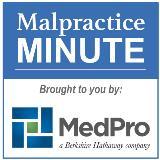
Dentist's Underestimation of Adverse Event Complications Leads to Malpractice Suit
Background
In the practice of dentistry, as in all healthcare, we strive for perfect results. However, sooner or later, a case occurs in which the results do not meet the expectations. This edition of Malpractice Minute reviews such a case and examines an adverse event and its after-effects.
Case Discussion
The patient was a 31-year-old female who presented to a dental practice with an emergency resulting from a badly decayed tooth number 2. The patient was new to the practice. She was assigned to Dr. Wilson, a dentist who was only in his third day with the practice after graduating from dental school. After clinical examination and X-rays, Dr. Wilson decided that the tooth was not viable and the patient needed an extraction. Appropriate informed consent to treatment was accomplished, and the procedure was commenced.
The extraction appeared uncomplicated, as tooth number 1 was already missing. Dr. Wilson attempted to elevate the tooth distally. During this process, he heard a slight crack, but did not think anything of it. Shortly thereafter, Dr. Wilson manipulated the tooth out of the patient's mouth; however, because a piece of the maxilla was inherent to the root, he had some difficulty separating the root and bone material from the soft tissue. Dr. Wilson placed the tooth on the bracket table and left the room to obtain suture material to close the opening in the mucosa.
When Dr. Wilson returned, he placed four sutures, gave the patient appropriate postoperative instructions, and, once he was satisfied that the bleeding had stopped, he sent the patient home without antibiotics (which he did not feel were warranted considering the routine nature of the procedure).
The following day, the patient called the practice to state that as she drank orange juice that morning, some of the juice was expressed through her right nostril. The receptionist scheduled the patient to see Dr. Wilson immediately. Upon examining the patient, Dr. Wilson concluded that an oro-antral communication had occurred, and he referred her to an oral surgeon for repair of the condition.
The oral surgeon saw the patient the following day and repaired a 1.5 cm defect. Because of the size of the defect and the contamination of the sinus tissue, the oral surgeon had a difficult time with the repair. Following the repair, the patient began to suffer chronic sinusitis and had to undergo two subsequent surgeries before a complete recovery was accomplished. Shortly thereafter, she consulted a malpractice attorney and brought a lawsuit against Dr. Wilson.
In preparation for the defense of the case, Dr. Wilson met with his malpractice defense attorney. At that meeting, Dr. Wilson produced the informed consent form, explained that he had used only minimal force in the removal of the tooth, and noted that although he was aware of some bony tissue attached to the root of the tooth, it was "very small." He further explained that he didn't feel that an immediate referral to an oral surgeon or the use of antibiotics was necessary. Based on this information, the decision was made to defend the case.
During the legal discovery process, the plaintiff's attorney produced a photograph of the tooth and bony tissue, which the patient had taken with her cellphone while Dr. Wilson was out of the room. The size of the bony material and its shape and composition made it clear that it was a significant amount from the floor of the sinus. After seeing the picture, Dr. Wilson and his defense attorney collaborated further and decided to settle the case in the midrange.
Risk Management Considerations
Theodore Passineau, JD, HRM, RPLU, CPHRM, FASHRM
This case discusses a situation that inevitably occurs in the delivery of healthcare — an adverse event, which is defined as any unexpected, suboptimal result of treatment. An adverse event might occur for a variety of reasons. Sometimes a mistake is made that follows a predictable course leading to an undesired outcome (for example, miscommunication between a general dentist and oral surgeon results in extraction of the wrong tooth).
In other cases, miscommunication might occur between the dentist and the patient that interferes with the desired outcome (for example, a patient does not understand or follow his or her aftercare instructions, resulting in an extraction becoming a dry socket).
In some cases, both the dental provider and the patient do everything correctly, but nature does not follow its usual course, and a problem results. This scenario is what appears to have happened in this case.
The case started out well — Dr. Wilson properly evaluated the patient, correctly diagnosed her condition, settled on an appropriate treatment technique, and secured the patient's informed consent to treatment. The documentation shows no evidence that Dr. Wilson used excessive force in loosening the tooth or made any other clinical missteps in the course of the extraction. However, probably for reasons we will never know, he clearly caused a breach in the integrity of the sinus floor during the extraction, resulting in the injury described previously.
Even when the utmost skill and care are exercised, adverse events can occur. The mere occurrence of an adverse event does not necessarily indicate that the practitioner has deviated from the standard of care.
In examining this case, two events stand out as possible situations that Dr. Wilson could have handled differently. First, it is clear that he significantly underestimated the amount of tissue that had been broken off from the sinus floor. In hindsight, it would have been wise for him to stop at that point and ask a more senior dentist to come in and evaluate what had happened and advise Dr. Wilson about what remedial steps he should take. In concept, this is no different than asking for a consultation when an adverse event has occurred.
Unfortunately, many practitioners consider requesting a consultation under these circumstances to reflect weakness or inadequate knowledge. Actually, requesting a consultation when things do not go as planned is a prime example of "playing it smart." Given how new Dr. Wilson was to practice, his colleagues should have encouraged him to seek the advice of a more senior dentist at the slightest indication of a problem.
Second, the adverse event was not disclosed to the patient. When treatment does not go as planned, the provider should inform the patient of the adverse event as early as possible, including what has occurred, why it has occurred (if known), and the recommended steps for remediation of the problem. In this case, none of these steps occurred, very possibly because Dr. Wilson did not recognize the seriousness of the situation. The worst case scenario is what occurred here — the patient was left to discover on her own that an adverse event had taken place.
Conclusion
No one is perfect all the time and mistakes happen — especially when someone is first getting started in his or her career. Although it might be difficult for some practitioners, seeking advice (either formally or informally) early and often is the best way to gain understanding and experience and to provide a safe environment for patients. In due time, nearly everyone becomes the one consulted, and the benefits of collaboration come clearly into focus.
Question
What immediate steps should a dentist take when an unexpected event occurs during treatment?






